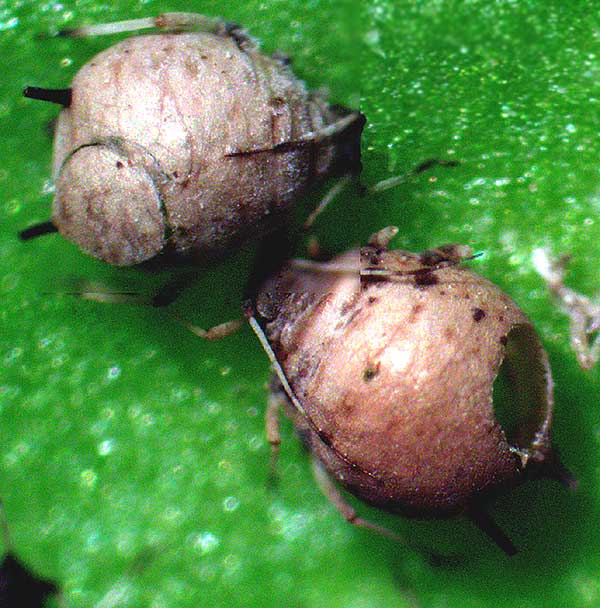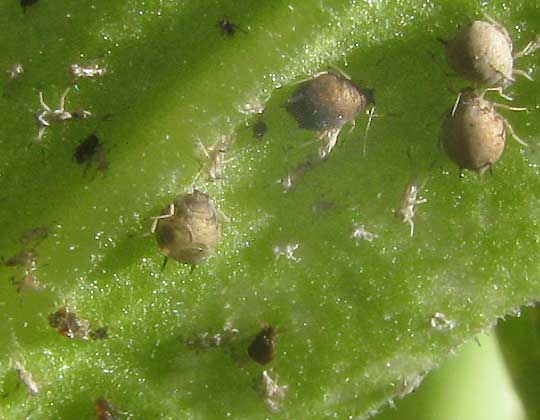Excerpts from Jim Conrad's
Naturalist Newsletter

from the March 3, 2013 Newsletter issued from the valley of the Dry Frio River in northern Uvalde County, southwestern Texas, on the southern border of the Edwards Plateau; elevation ~1750m (~5750 ft); N29.62°, W99.86°; USA
APHID MUMMIES
During January's chilly days our pot of Calendulas became infested with aphids and the plants began looking droopy and anemic. But now that spring with warmer and longer days is arriving the Calendulas are perking up and the aphid population has diminished dramatically. I'd thought that maybe with more warmth and sunlight the Calendulas' immune system may have kicked in causing the aphids' decline, but after taking a closer look, I'm suspecting something else may be behind it.
First, below you see a typical patch of Calendula leaf undersurface occupied with aphids.

In that picture there's only one living aphid, the dark one at the image's bottom center. The white, papery items are exoskeletons shed by growing aphids. The four spherical, tan-colored forms are aphid mummies, and in that, there's a story. The close-up of two mummies at the top of this page hints at the story. In that picture one mummy's rear end has a circular hole in it and the other mummy's rear end has a hole with the lid still on it.
The story begins when a tiny wasp inserts an egg into the aphid. In about two days a wasp grub hatches and feeds on the living aphid by osmosis for about six to eight days, killing the aphid. During this time the larva expands in size so that the aphid's body swells, giving it a bloated appearance. The larva cuts a slit in the bottom of the aphid, and, working from inside the aphid, attaches the dead aphid to the leaf with silk and glue. Then the wasp grub still inside the mummy molts to the pupal stage as the dead aphid turns from green to brown, becoming a "mummy." After four or five days a wasp emerges from the pupa inside the mummy and exists the aphid by cutting a circular hole in the mummy's top. If you don't believe that, I actually observed a black wasp emerging from a mummy's rear end, shown below.
 Wasp parasitization not only controls aphid populations by killing individual aphids, but also by reducing the living parasitized aphid's reproductive rate. Parasitized aphids stop reproducing within one to five days, while healthy aphids give birth to three or four live aphids each day for 25-30 days.
Wasp parasitization not only controls aphid populations by killing individual aphids, but also by reducing the living parasitized aphid's reproductive rate. Parasitized aphids stop reproducing within one to five days, while healthy aphids give birth to three or four live aphids each day for 25-30 days.
The control of aphids by introducing parasitic wasps into infested areas is an established procedure in the field of biological control. One website sells 500 wasps for US$43.00, or 10,000 wasps for $340. The wasps, whose name is Aphidius colemani, are shipped as parasitized aphid mummies from which adult wasps will emerge and theoretically parasitize many more than just one aphid. For control of aphids on an acre of land, it's suggested that 500-3,000 wasps be released two or three times, one week apart, depending on the extent of infestation.